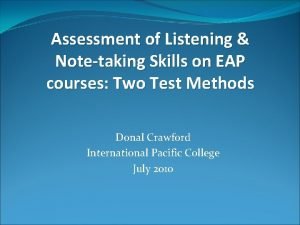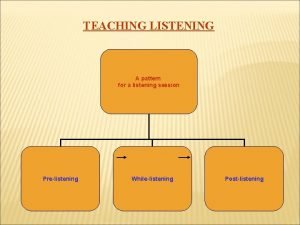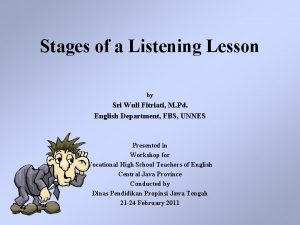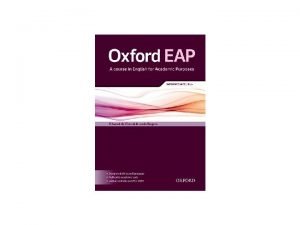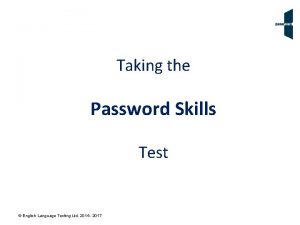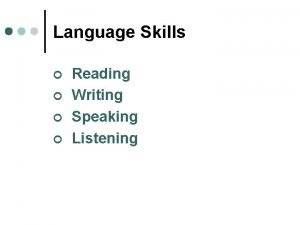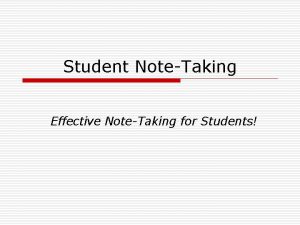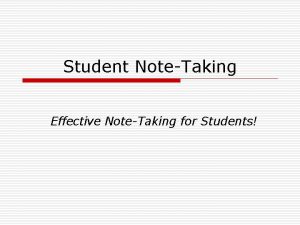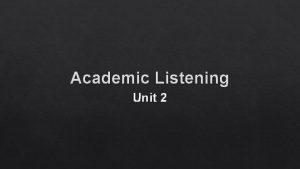Listening English for Academic Study Unit 5 Notetaking






























- Slides: 30

Listening English for Academic Study Unit 5 Note-taking: Part 2 1

Outline Ø Introduction Ø Teaching demo Ø Assessment 2

Outline ØIntroduction Ø Teaching demo Ø Assessment 3

Introduction Listening English for Academic Study Unit 5 Note-taking: Part 2 4

Introduction 1. Target Students: Non- English major, freshmen, A level High English proficiency Autonomous learning Well-motivated Explorative learning Hard working Cooperative learning 5

Introduction 2. Teaching Objectives: what are the strategies to improve note-taking efficiency how to use abbreviation and symbols in note taking how to organize notes with different formats what are phonetic changes in oral English 6

Introduction 3. Teaching Methodology: Ø Skill-based teaching Ø Learning-centered teaching Ø Cooperative learning 4 - period smart design 7

Introduction 4. Smart design: Teaching Material : SARS Online Offline • video • Article • Website/AP P • Textbooks • Contribution from Students ü authentic ü diverse ü resourceful 8

Introduction 4. Smart design: Teaching Material : SARS Online Offline • video • Article • Website/AP P • Textbooks • Contribution from Students ü authentic ü diverse ü resourceful ü Classical ü Well-facilitated ü Personalize 9

Introduction 4. Smart design: Teaching Procedure In Class • Diverse input • Leaningcentered • Active learning steps After class • Autonomous learning • Selfassessment • Online collaboration observe analyze practice reflect 10

Introduction 4. Smart design: Teaching Procedure In Class • Diverse input • Leaningcentered • Active learning steps After class • Autonomous learning • Selfassessment • Online collaboration 11

Outline Ø Introduction ØTeaching demo Ø Assessment 12

Lead in Let’s compare! 1 2 n r b b A io t a i ev

What is abbreviation? Abbreviation is a shortened form of a word or phrase, used to represent the whole, as km for kilometer, DEC for December and NY for New York. 14

Let’s brainstorm! 1 2 3 + 15

More examples C ud o l C on i t a r o b a oll 16

How to abbreviate a word? 1. How many letters we should retain to abbreviate a word? 2. What letters of a word can we retain in abbreviation?

How to abbreviate a word? 1. How many letters we should retain to abbreviate word? develop student ØAround student 3 letters. develop a stu dev 2. What lettersstudent of a word can we retain in abbreviation? develop stt dvlp ØUse the first few letters. ØRemove the vowels. 18

Let’s practice! Who can take down the most words?

Let’s practice! Purpose of Education 20

Reflection Ø Is abbreviation useful in note-taking? Ø What possible difficulties do you have when abbreviating words? Ø What can you do to improve abbreviating words in note-taking?

Self-assessment Scan the code Online survey 22

23

24

25

Self-assessment ta a d Big ysis l a n a 26

Assignment 1 Listen to a lecture and take notes. 2 Log on the website and read supplementary material for Unit 5 as a review: www. englishforacademicstudy. com 27

Outline Ø Introduction Ø Teaching demo ØAssessment 28

Assessment 1. Which abbreviation stands for “in other words”? A. i. e. B. c. f. C. N. B. D. e. g. 2. What is the possible abbreviation for the word “parents” in note taking? A. par B. part C. prts D. parn 29

30
 Listening and notetaking skills
Listening and notetaking skills Pre listening while-listening and post listening examples
Pre listening while-listening and post listening examples Stages of a listening lesson
Stages of a listening lesson Active listening passive listening
Active listening passive listening Evaluative listening examples
Evaluative listening examples Si vs english units
Si vs english units Academic english reading and writing across the disciplines
Academic english reading and writing across the disciplines Academic english presentation
Academic english presentation Oxford eap a course in english for academic purposes
Oxford eap a course in english for academic purposes Unit 10, unit 10 review tests, unit 10 general test
Unit 10, unit 10 review tests, unit 10 general test Password english language test
Password english language test Prove invalsi oxford
Prove invalsi oxford Password english test listening
Password english test listening Listening speaking reading writing skills
Listening speaking reading writing skills [email protected]
[email protected] Kontinuitetshantering
Kontinuitetshantering Typiska novell drag
Typiska novell drag Nationell inriktning för artificiell intelligens
Nationell inriktning för artificiell intelligens Ekologiskt fotavtryck
Ekologiskt fotavtryck Varför kallas perioden 1918-1939 för mellankrigstiden?
Varför kallas perioden 1918-1939 för mellankrigstiden? En lathund för arbete med kontinuitetshantering
En lathund för arbete med kontinuitetshantering Underlag för särskild löneskatt på pensionskostnader
Underlag för särskild löneskatt på pensionskostnader Tidbok yrkesförare
Tidbok yrkesförare Sura för anatom
Sura för anatom Förklara densitet för barn
Förklara densitet för barn Datorkunskap för nybörjare
Datorkunskap för nybörjare Tack för att ni lyssnade bild
Tack för att ni lyssnade bild Att skriva en debattartikel
Att skriva en debattartikel Magnetsjukhus
Magnetsjukhus Nyckelkompetenser för livslångt lärande
Nyckelkompetenser för livslångt lärande Påbyggnader för flakfordon
Påbyggnader för flakfordon
